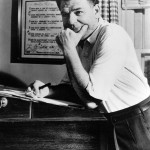Before you write lyrics for your show, you should be aware of two distinctions. First, there is a difference between lyrics and poetry. Poems live on the page, lyrics live on the stage. We read poems at our own pace, but we hear lyrics at the pace of the music.
Second, there is a difference between theater lyrics and pop lyrics. Composer Jason Robert Brown said, “Pop songs are about establishing a mood. … Theater songs are about going to a different place.” Songwriter Benj Pasek put it this way: “A pop song is like an adjective. … A theater song is like a verb.” As I wrote in yesterday’s post, the songs in your show are not relief from the action, they are the action.
To help the audience understand our songs, we need to be aware of two main aspects of speech. First is phonetics (word sounds). Some combinations of sounds are hard to understand. For example, “Excuse me while I kiss the sky,” in Jimi Hendrix’s song “Purple Haze,” is often heard as “Excuse me while I kiss this guy.”
The second is semantics (word meanings). Some combinations of words are hard to understand. The best lyrics are conversational. Avoid inverting a phrase for a rhyme, like “When we go out and walk, with you I like to talk.”
Now, let’s start building a lyric. First, choose a title. The title will be the focus of your main idea and imagery. If you “head out on the highway” “until your ship comes in,” you will confuse the audience. Make a list of words, images, and phrases that your title brings to mind. Next, group those items into the patterns, themes, or structures you notice. Then choose three groups for your beginning, middle, and end. You may end up with more than three sections, but choose three for now. Organize those three groups so the items flow in a logical pattern, each section adding something new about your idea.
For example, listen to Oscar Hammerstein’s lyric of “Some Enchanted Evening” for Emile in South Pacific. Beginning, looking across the room (“You may see a stranger”). Middle, listening across the room (“You may hear her laughing”). End, moving across the room (“When you feel her call you”). Reading the lyric, you can almost see Emile as he discovers his new love. Seeing your character in motion is a good exercise to help structure your lyric. Also notice the other level of organization in this lyric, the grouping of sensory images: seeing, hearing, and feeling.
Next, listen to Alan Jay Lerner’s lyric of “On the Street Where You Live” for Freddie in My Fair Lady. Beginning, entering the street (“I have often walked”). Middle, walking down the street (“Are there lilac trees”). End, stopping on the street (“People stop and stare”). Again, just reading the lyric, you can almost see Freddie in action. Also notice how Lerner grouped his images in emotional power: inanimate objects in the beginning; nature in the middle; and people in the end.
Before I close, here’s advice from Oscar Hammerstein’s “Notes on Lyrics,” when you think your lyric isn’t good enough: “The most important ingredient of a good song is sincerity. … However important, however trivial, believe it.”
To see how lyrics look on the page, dip into Hal Leonard’s Lyric Library series. Each book has about 200 songs from one genre, including two volumes of Broadway songs.
Next, organizing your lyric.

